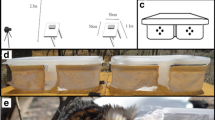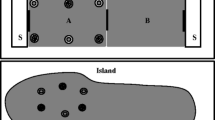Abstract
This work suggests how food storing corvids use spatial memory to relocate caches, and how they can do this after some landmarks surrounding caches have become hidden due to leaf fall, snow fall or plant growth. Experiments involved training European jays (Garrulus glandarius) to find buried food, the location of which was specified by an array of 12 landmarks. Tests were then performed with the array rotated, or with certain landmarks removed from the array. The main findings were: (1) birds primarily remembered the position of the goal using the near tall landmarks (15–30 cm from the goal and 20 cm high); (2) birds obtained a sense of direction both from the landmark array and something external to the array; (3) birds did not use smell or marks in the surface of the ground to find the goal. Memory of near tall landmarks is likely to be functional for these birds since (a) nearer landmarks provide a more accurate fix, and (b) taller landmarks are less likely to be completely obscured by snow fall, leaf fall or intervening vegetation. The work also demonstrates the use of G.I.S. software for the analysis and representation of animal search patterns.
Similar content being viewed by others
References
Abacus Concepts Inc (1988) Statview SE + GRAPHICS. Berkeley, California
Andersson M, Krebs JR (1978) On the evolution of hoarding behaviour. Anim Behav 26:707–711
Armitage P, Berry G (1987) Statistical methods in medical research. Blackwell, Oxford
Balda RP, Kamil AC (1989) A comparative study of cache recovery by three corvid species. Anim Behav 38:486–495
Balda RP, Kamil AC (1992) Long-term spatial memory in Clark's nutcracker, Nucifraga columbiana. Anim Behav 44:761–769
Balda RP, Bunch KG, Kamil AC, Sherry DF, Tomback DF (1987) Cache site memory in birds. In: Kamil AC, Krebs JR, Pulliam HR (eds) Foraging behavior. Plenum Press, New York
Bossema I (1979) Jays and oaks: an eco-ethological study of a symbiosis. Behaviour 70:1–117
Bressers M, Meelis E, Haccou P, Kruk M (1991) When did it really start or stop the impact of censored observations on the analysis of durations. Behav Processes 23:1–20
Cheng K (1988) Some psychophysics of the pigeon's use of landmarks. J Comp Physiol A 162:815–826
Cheng K (1989) The vector sum model of pigeon landmark use. J Exp Psychol, Anim Behav Proc 15:366–375
Cheng K (1990) More psychophysics of the pigeon's use of landmarks. J Comp Physiol A 166:857–863
Cheng K, Collett TS, Pickhard A, Wehner R (1987) The use of visual landmarks by honeybees: bees weight landmarks according to their distance from the goal. J Comp Physiol A 161:469–475
Chettleburgh MR (1952) Observations on the collection and burial of acorns by jays in Hainault Forest. Brit Birds 45:359–364
Collett TS (1987) The use of visual landmarks by gerbils: reaching a goal when landmarks are displaced. J Comp Physiol A 160:109–113
Collett TS, Kelber A (1988) The retrieval of visuo-spatial memories by honeybees. J Comp Physiol A 163:145–150
Collett TS, Cartwright BA, Smith BA (1986) Landmark learning and visuo-spatial memories in gerbils. J Comp Physiol A 158:835–851
Collett TS, Dillmann E, Giger A, Wehner R (1992) Visual landmarks and route following in desert ants. J Comp Physiol A 170:435–442
Jacobs LF, Liman ER (1991) Grey squirrels remember the locations of buried nuts. Anim Behav 41:103–110
McNamara JM, Houston AI, Krebs JR (1990) Why hoard? The economics of food storing in tits, Parus spp. Behav Ecol 1:12–23
Morris RGM (1981) Spatial localization does not require the presence of local cues. Learning and Motivation 12:239–260
Schuster L (1950) Ueber den Sammeltrieb des Eichelhähers (Garrulus glandarius). Vogelwelt 71:9–17
Sherry DF (1992) Landmarks, the hippocampus, and spatial search in food-storing birds. In: Honig WK, Fetterman JG (eds) Cognitive aspects of stimulus control. LEA, Hillsdale, NJ
Shettleworth SJ (1990) Spatial memory in food-storing birds. In: Krebs JR, Horn G (eds) Behavioural and neural aspects of learning and memory. Oxford University Press, Oxford
Sokal RR, Rohlf FJ (1981) Biometry, 2nd Ed. WH Freeman and Co, New York
Spetch ML, Edwards CA (1988) Pigeons', Columba livia, use of global and local cues for spatial memory. Anim Behav 36:293–296
Swanberg PO (1951) Food storage, territory and song in the thick-billed nutcracker. Proc Xth Intern Ornithol Cong (1950) 10:545–554
Swanberg PO (1969) Jays recovering food from under snow. Brit Birds 62:238–240
Thompson DC, Thompson PS (1980) Food habits and caching behaviour of urban grey squirrels. Can J Zool 58:701–710
Tinbergen N (1972) The animal in its world, Vol 1: Field studies. George Allen & Unwin Ltd, London
Tomback DF (1980) How nutcrackers find their seed stores. Condor 82:10–19
Warburton K (1990) The use of local landmarks by foraging goldfish. Anim Behav 40:500–505
Wiltschko W, Balda RP (1989) Sun compass orientation in seedcaching scrub jays (Aphelocoma coerulescens). J Comp Physiol A 164:717–721
Winer BJ, Brown DR, Michels KM (1991) Statistical principles in experimental design. McGraw-Hill,
Author information
Authors and Affiliations
Rights and permissions
About this article
Cite this article
Bennett, A.T.D. Spatial memory in a food storing corvid. J Comp Physiol A 173, 193–207 (1993). https://doi.org/10.1007/BF00192978
Accepted:
Issue Date:
DOI: https://doi.org/10.1007/BF00192978




